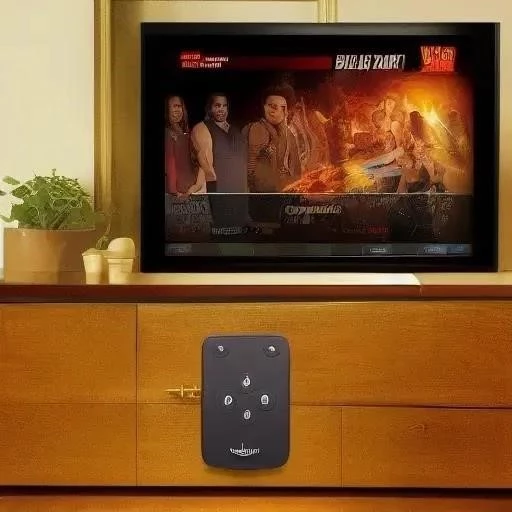The Amazon Fire Stick is a fantastic streaming device, offering access to a vast library of content from services like Netflix, Prime Video, and Disney+. However, using the Amazon Fire Stick outside of US can present some challenges due to geo-restrictions and licensing agreements. Many users find themselves wondering how to bypass these limitations and enjoy their favorite shows and movies, no matter where they are in the world. This guide will walk you through the steps and considerations involved in effectively utilizing your Amazon Fire Stick outside of US, ensuring a seamless and enjoyable streaming experience.
Geo-restrictions are limitations placed on content based on your geographical location. Streaming services often employ these restrictions to comply with copyright laws and licensing agreements, meaning that content available in the US may not be accessible in other countries. When you attempt to access content from outside the US, you might encounter error messages or be unable to stream certain titles. Several factors contribute to these restrictions, including:
- Copyright Laws: Different countries have different copyright laws, influencing content availability.
- Licensing Agreements: Streaming services negotiate licensing agreements with content providers on a country-by-country basis.
- Regional Distribution: Some content is intended for specific regional audiences.
Fortunately, there are several methods to bypass geo-restrictions and unlock content on your Amazon Fire Stick outside of the US:
Using a VPN (Virtual Private Network)
A VPN is the most common and reliable method for bypassing geo-restrictions. A VPN encrypts your internet traffic and routes it through a server in a location of your choice, effectively masking your true IP address. Here’s how to use a VPN with your Fire Stick:
- Choose a Reputable VPN Provider: Research and select a VPN provider with servers in the US and a strong reputation for security and privacy.
- Install the VPN App: Many VPN providers offer dedicated apps for the Amazon Fire Stick; Download and install the app from the Amazon Appstore.
- Connect to a US Server: Open the VPN app and connect to a server located in the United States.
- Start Streaming: Once connected, your Fire Stick will appear to be accessing the internet from the US, allowing you to stream content as if you were physically located there.
A Smart DNS proxy is another option for bypassing geo-restrictions. Unlike a VPN, a Smart DNS proxy doesn’t encrypt your traffic but simply redirects your DNS requests through a server in the US. This method is generally faster than a VPN but may not offer the same level of security and privacy.
When choosing between a VPN and a Smart DNS proxy, consider the following factors:
| Feature | VPN | Smart DNS Proxy |
|---|---|---|
| Security | High (Encryption) | Low (No Encryption) |
| Speed | Potentially Slower (Due to Encryption) | Generally Faster |
| Ease of Use | Easy (Dedicated Apps) | Slightly More Complex Setup |
Before you get started, remember that it’s always wise to check the terms of service of your streaming services to ensure compliance with their policies.
Even with a VPN or Smart DNS proxy, you might encounter occasional issues. Here are some common problems and their solutions:
- Buffering: If you experience buffering issues, try connecting to a different VPN server or switching to a Smart DNS proxy.
- Error Messages: If you see error messages, clear the cache and data of the streaming app or restart your Fire Stick.
- VPN Not Working: Ensure your VPN is properly connected and that your IP address is correctly masked.
But what about the legality of using these methods? Are you breaching any terms of service by circumventing geo-restrictions? Should you be concerned about potential repercussions from streaming services or content providers? Is it really worth the effort of setting up a VPN or Smart DNS proxy, or would it be easier to simply subscribe to local streaming services? Perhaps the biggest question is, will your internet speed be significantly impacted by using a VPN, making your streaming experience less enjoyable?
Alternative Solutions: Are There Other Options?
Are you aware of other alternatives to VPNs and Smart DNS proxies? Could you explore options like downloading content and watching it offline, if that’s even possible with your desired streaming service? What if you considered purchasing a pre-configured streaming device specifically designed for international use, would that simplify the entire process? Or, have you thought about simply changing your Amazon account’s region, and would that even solve the problem without causing further complications?
Exploring Content Availability: What Can You Actually Watch?
Have you checked which streaming services and apps are actually available in your current location? Will your favorite shows and movies still be accessible even with a VPN, or are there additional restrictions you need to be aware of? Can you be certain that all the content available in the US version of a streaming service will be available when using a US-based VPN server from another country? What about subtitles and audio options – will they be available in your preferred language?
The Future of Geo-Restrictions: Will This Always Be Necessary?
Ultimately, will geo-restrictions always be a hurdle for international streamers? Are streaming services moving towards a more global approach, offering consistent content libraries across different regions? Could advancements in technology eventually eliminate the need for VPNs and Smart DNS proxies altogether? With increasing pressure from consumers, might content providers be forced to relax their geo-restrictions in the future, making it easier to access content from anywhere in the world? What changes can we anticipate in the streaming landscape regarding regional content availability? The question remains: Will enjoying your Amazon Fire Stick outside of US ever truly be hassle-free?
‘ARTICLE DESIGN:
1. No citations.
ARTICLE STRUCTURE:
1. Start the article with the H1 heading without additional tags.
2. 100% unique, which no one has ever written anywhere.
3. Use h2 and h3 subheadings, as well as bulleted lists, at least 2 times.
4. The first paragraph of the article should consist of at least 4 sentences.
5. Monitor the variety of sentence lengths to improve readability and in accordance with all spelling and orthography rules;
6. The keyword should be used exactly 4 times in the article: 2 times in the first paragraph, 1 time in the middle of the article and 1 time in the first sentence of the final paragraph.
7. Add comparative tables if desired.’
‘A Guide to Using the Amazon Fire Stick Outside of US’
Understanding Geo-Restrictions
Geo-restrictions are limitations placed on content based on your geographical location. Streaming services often employ these restrictions to comply with copyright laws and licensing agreements, meaning that content available in the US may not be accessible in other countries. When you attempt to access content from outside the US, you might encounter error messages or be unable to stream certain titles. Several factors contribute to these restrictions, including:
- Copyright Laws: Different countries have different copyright laws, influencing content availability.
- Licensing Agreements: Streaming services negotiate licensing agreements with content providers on a country-by-country basis.
- Regional Distribution: Some content is intended for specific regional audiences.
Methods to Bypass Geo-Restrictions
Fortunately, there are several methods to bypass geo-restrictions and unlock content on your Amazon Fire Stick outside of the US:
Using a VPN (Virtual Private Network)
A VPN is the most common and reliable method for bypassing geo-restrictions. A VPN encrypts your internet traffic and routes it through a server in a location of your choice, effectively masking your true IP address. Here’s how to use a VPN with your Fire Stick:
- Choose a Reputable VPN Provider: Research and select a VPN provider with servers in the US and a strong reputation for security and privacy.
- Install the VPN App: Many VPN providers offer dedicated apps for the Amazon Fire Stick. Download and install the app from the Amazon Appstore.
- Connect to a US Server: Open the VPN app and connect to a server located in the United States.
- Start Streaming: Once connected, your Fire Stick will appear to be accessing the internet from the US, allowing you to stream content as if you were physically located there.
Using a Smart DNS Proxy
A Smart DNS proxy is another option for bypassing geo-restrictions. Unlike a VPN, a Smart DNS proxy doesn’t encrypt your traffic but simply redirects your DNS requests through a server in the US. This method is generally faster than a VPN but may not offer the same level of security and privacy.
Considerations for Choosing a Method
When choosing between a VPN and a Smart DNS proxy, consider the following factors:
| Feature | VPN | Smart DNS Proxy |
|---|---|---|
| Security | High (Encryption) | Low (No Encryption) |
| Speed | Potentially Slower (Due to Encryption) | Generally Faster |
| Ease of Use | Easy (Dedicated Apps) | Slightly More Complex Setup |
Before you get started, remember that it’s always wise to check the terms of service of your streaming services to ensure compliance with their policies.
Troubleshooting Common Issues
Even with a VPN or Smart DNS proxy, you might encounter occasional issues. Here are some common problems and their solutions:
- Buffering: If you experience buffering issues, try connecting to a different VPN server or switching to a Smart DNS proxy.
- Error Messages: If you see error messages, clear the cache and data of the streaming app or restart your Fire Stick.
- VPN Not Working: Ensure your VPN is properly connected and that your IP address is correctly masked.
But what about the legality of using these methods? Are you breaching any terms of service by circumventing geo-restrictions? Should you be concerned about potential repercussions from streaming services or content providers? Is it really worth the effort of setting up a VPN or Smart DNS proxy, or would it be easier to simply subscribe to local streaming services? Perhaps the biggest question is, will your internet speed be significantly impacted by using a VPN, making your streaming experience less enjoyable?
Alternative Solutions: Are There Other Options?
Are you aware of other alternatives to VPNs and Smart DNS proxies? Could you explore options like downloading content and watching it offline, if that’s even possible with your desired streaming service? What if you considered purchasing a pre-configured streaming device specifically designed for international use, would that simplify the entire process? Or, have you thought about simply changing your Amazon account’s region, and would that even solve the problem without causing further complications?
Exploring Content Availability: What Can You Actually Watch?
Have you checked which streaming services and apps are actually available in your current location? Will your favorite shows and movies still be accessible even with a VPN, or are there additional restrictions you need to be aware of? Can you be certain that all the content available in the US version of a streaming service will be available when using a US-based VPN server from another country? What about subtitles and audio options – will they be available in your preferred language?
The Future of Geo-Restrictions: Will This Always Be Necessary?
Ultimately, will geo-restrictions always be a hurdle for international streamers? Are streaming services moving towards a more global approach, offering consistent content libraries across different regions? Could advancements in technology eventually eliminate the need for VPNs and Smart DNS proxies altogether? With increasing pressure from consumers, might content providers be forced to relax their geo-restrictions in the future, making it easier to access content from anywhere in the world? What changes can we anticipate in the streaming landscape regarding regional content availability? The question remains: Will enjoying your Amazon Fire Stick outside of US ever truly be hassle-free?
So, considering all these potential pitfalls and workarounds, isn’t it crucial to weigh the pros and cons before committing to using your Amazon Fire Stick outside of US? Have you fully considered the potential security implications of using a VPN, particularly when it comes to your personal data? Are free VPN services truly safe, or do they come with hidden costs and potential privacy breaches? Shouldn’t you research the legal landscape regarding VPN usage in your specific country of residence?
Security & Privacy: Are You Truly Protected?
Beyond simply accessing content, are you actively thinking about the security of your Fire Stick and your home network while using these methods? Could your Fire Stick become vulnerable to malware or hacking attempts if you’re not careful about the apps you install and the websites you visit? Should you be using a strong password and enabling two-factor authentication on your Amazon account to prevent unauthorized access? And what about the privacy policies of the streaming services themselves – are you comfortable with how they collect and use your viewing data?
Cost Analysis: Is It Worth the Investment?
Beyond the initial cost of the Amazon Fire Stick, have you factored in the ongoing expenses of a VPN subscription or Smart DNS proxy service? Will the cost of these services outweigh the benefits of accessing a wider range of content? Could you potentially save money by simply subscribing to a few local streaming services that offer the content you’re most interested in? Or perhaps, would exploring free and legal streaming alternatives be a more cost-effective solution?
Long-Term Viability: Is This a Sustainable Solution?
Finally, considering the ever-changing landscape of streaming technology and content licensing, is bypassing geo-restrictions a sustainable long-term solution? Will streaming services continue to tolerate the use of VPNs and Smart DNS proxies, or will they implement stricter measures to block them? Could new technologies emerge that make geo-restrictions obsolete, rendering VPNs and Smart DNS proxies unnecessary? Isn’t it wise to stay informed about the latest developments in the streaming industry to ensure you’re using the most effective and reliable methods for accessing content from anywhere in the world?



